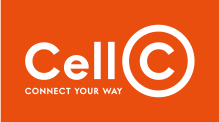Cell C
Cell C Limited (stylised as Cell ©)operates as a customer-first mobile operator in South Africa. The Company promotes digital inclusion and enhances lives by delivering world-class products and services to empower and connect people in a way they choose.
 | |
| Private | |
| Industry | Telecommunications |
| Headquarters | Sandton, South Africa |
Key people | Douglas Craigie Stevenson (CEO) |
| Products | GSM services (2G, 3G, LTE) and fibre |
| Website | www |
Current shareholding
Following the successful conclusion of the recapitalisation of Cell C in August 2017 the current shareholding of the company is as follows:
- Blue Label Telecoms, through The Prepaid Company, holds 45%;
- Net1 Applied Technologies South Africa holds 15%;
- Three Special Purpose Vehicles (SPVs) collectively hold 30% (in turn held by 3C Telecommunications and further in turn held as 29.4% by the Employee Believe Trust, 45.6% by Oger Telecoms and 25% by broad-based black empowerment grouping CellSAf);
- Cell C Management and Staff hold 10%.
Historical shareholding
At launch, Cell C was wholly owned by 3C Telecommunications, which in turn was 60% owned by Oger Telecom South Africa, a division of Saudi Oger; 25% owned by CellSAf, (a Broad-Based Black Economic Empowerment entity which represents over 30 black empowerment companies and trusts), and 15% by Lanun Securities SA (Lanun is a wholly owned subsidiary of Saudi Oger Ltd).
Technology
Cell C's range of products and services is supported by its network which offers 2G, 3G and LTE services and covers 98% of South Africa's population; the company has a roaming agreement in place with Vodacom to provide 2G and 3G services to customers in outlying areas. In 2015, Cell C announced an investment of approximately R8 billion to roll out LTE across the country. The company has already launched its LTE services in Gauteng, Kwa-Zulu Natal and the Western Cape and will continue its rollout across other metros. Cell C started the rollout of LTE-Advanced and has actively tested LTE-U (LTE in unlicensed spectrum) showing download speeds of 600 Mbit/s. The Cell C network operates on three key bands: 900 MHz, 1800 MHz and 2100 MHz.
Challenger Network
Cell C has almost tripled its customer base since 2012, acting as a disruptor and pushing for regulatory changes such as lower and asymmetrical mobile termination rates. A study commissioned by the South African National Treasury and conducted by the University of Johannesburg's Centre for Competition, Regulation and Economic Development found that the lower termination rates introduced in 2011 has saved South African consumers R47 billion over five years.[1]
Sponsorships
Cell C sponsors a range of teams and events, including:
- Cell C Sharks
- E! Live from the Red Carpet
- Southern Equatorial Ferrari Automobili Club
- South African Rugby Legends Association
- Cell C Playing for Pink Polo
- Cell C Inanda Africa Cup
References
- "Barriers to Entry". CCRED. Archived from the original on 2016-09-14. Retrieved 2016-09-05.
External links
| Wikimedia Commons has media related to Cell C. |